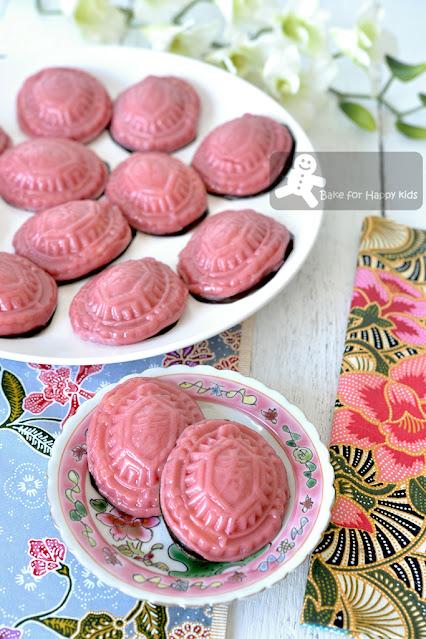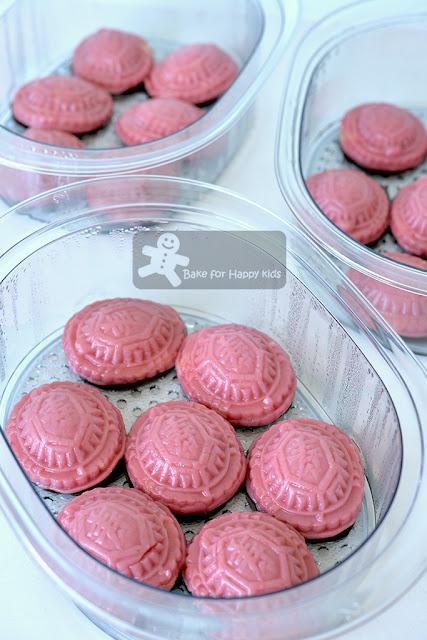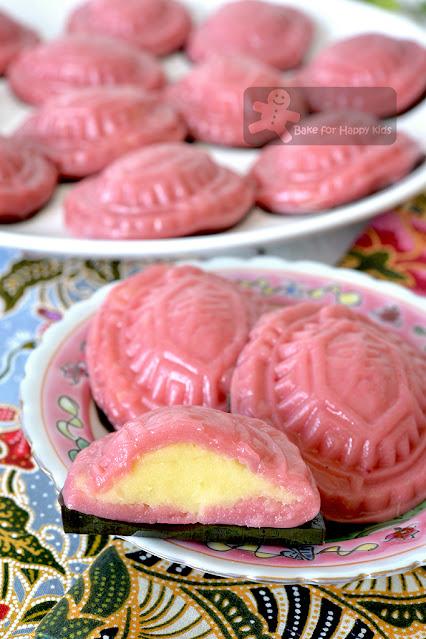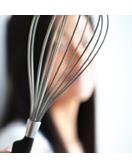Why PINK?!!!
Is Zoe mad?
LOL!!!
Pink because I want to make these kueh to be specially flavoured with rosewater and milk powder so that they will taste like bandung which is a Southeast iced drink that is made with evaporated milk or condensed milk flavoured and rose syrup that has a signature pink color.Hence, this is why I made these kueh pink just like the traditional bandung drinks. Interestingly, they really taste like bandung but in the form of ang ku kueh instead of iced drinks. I must admit these quirky rosewater pink ku kueh with milky mung bean filling are strange and way out of the traditional flavours... but they are delicious!!! And I can't help to say this... this wacky idea is actually brilliant!!! LOL!!!

My Pink Bandung / Rosewater Ku Kueh with Milky Mung Bean Filling
Crazy but cute? LOL!!!
To make them pink, I used the sweet potatoes with white flesh and added the natural pink cochineal food colouring into the skin dough. Cochineal? According toWikipedia, Cochineal is an insect which a natural red / pink dye (carmine) is derived. Otherwise, you can use beet root powder if you prefer a plant-based option but beet root powder is slightly acidic and sourish.
Do you want to know? How much sugar are in these sweet-smelling pink ku kueh? Let's do some calculation.Total weight of filling = 546gSugar added into filling = 50gSugar in 50g added milk powder into filling = 19gTotal added sugar (including the sugar in the added milk powder) = 69g
Added sugar per g of filling = 0.13g
Added sugar in each 18g filling per ang ku kueh = 2.34g
Added sugar in each 27g skin = 20g / 22 portions = 0.90g
Total added sugar in each ang ku kueh = 2.34g (from filling) + 0.90g (from skin) = 3.24g
Each of my low-sugar ang ku kueh at HERE and these bandung pink ku kueh contains even less than a teaspoon of sugar, 5g!Unlike the kueh skin made with the golden sweet potato at HERE, I do realize that this skin that is made with the white flesh sweet potatoes is rather drier and crumbly as it requires more added oil in order to make the dough more pliable and easier to handle. Despite my observation, I still resist adding more oil into my kueh skin and was actually struggling a little to assemble these kueh... if you want my video very closely. Ops! Having said that, I will still choose to make these kueh with the less amount of oil even if I'm making them again in the future. In conclusion... if you are struggling assembling your kueh:- You can brush and knead the dough with more oil but small amount of oil at a time until the skin is pliable, smooth and manageable. Or- You can choose to be stubborn like me! LOL!!! It's ok as you will enjoy slightly less pretty but healthier kueh with less added oil.Nevertheless, both kueh with more or less added oil will have the same fantastic bandung taste! So the choice is really up to you...Last and most importantly, you must remember to steam these kuehs with gentle heat. Steaming with too high heat will cause your kueh to expand and become flattened, resulting the imprints on the kueh to be blurred and smeared.

Happy that my kuih are so pretty in pink ^-^

chewy, creamy, milky and yummy too ^-^
Now, which is better? These wacky bandung pink ku kueh, the classic sweet potato red ang ku kueh at HERE or the very-black-sesame ang ku kueh at HERE?
I must say all are nice in their own ways. So why not? Try making these. You might like them more than the traditional ones ^-^
Watch my video showing how I made the kueh.Music: Bensound
If you like my recipes, videos and baking tips, please LIKE, SHARE and FOLLOW me at either my Facebook at here or here or my Instagram @zoebakeforhappykids or SUBSCRIBE my YouTube channel at here.Unfortunately, I know that Facebook and Instagram have lost its popularity recently. Hence, it will be nice if you can show your support by subscribing to
my YouTube channel at here so that you will be informed of my latest video / recipe promptly whenever it is published.I would like to say again that every LIKE, SHARE and FOLLOW or SUBSCRIBE from you means a lot to me. I will know that I'm in the right track and continue to bake and share more in the future. Thank you so much for your support!Here’s the recipe.
Makes about 22 depending on the size of the mould
For the filling:
160g mung beans (without skin), rinsed with cold water
50g caster sugar
1/2 tsp salt
50g milk powder
35g neutral-tasting vegetable oil, plus more if required
For the skin:
about 400g sweet potato with white flesh, peeled and cut into pieces
200g glutinous rice flour
20g caster sugar
30g neural-tasting vegetable oil, plus more if required
4 tbsp rosewater - Depending on the brand of the rosewater you used, you can add slightly more or less accordingly to your preference.
1/4 tsp to 1 tbsp pink colouring depending on the type / brand of colouring you used - I added 1 tbsp because mine is a natural colouring that is a lot less intense than the artificial colouring.
1-2 tbsp water, optional - add only if required
banana leaves, cut into pieces (about 22) that are the same size of your ang ku kueh
1-2 tbsp neutral tasting vegetable oil for brushing and assembly
For the filling:
Place beans in a large bowl or container and fill the bowl or the container with adequate water. Cover the bowl or container and leave the bean in the fridge to soak overnight.
On the next day, pour off the soaking water. Wash the beans with extra water and drain them thoroughly, then transfer the beans into a heat proof container.
Steam the beans with high heat for 30 mins or until soft. When the beans are cooked, pour the beans into a sieve to drain any excess liquid.
Do ahead: You can steam the beans one day before making the kueh and keep the steamed beans in a fridge until ready to use.
Using a food processor or blender, process the beans to form a smooth paste. You may add 2-4 tbsp water into the mixture if the mixture is too dry to process.
Transfer into a non-stick saucepan. Cook paste using medium low heat with constant stirring until the paste is semi-dry and fragrant, about 15 mins, when you will see thin layers of mung bean sticking on the bottom and the sides of the pan. Keep stirring, scrapping off the layers of the paste that sticks on the pan until you can smell that the paste is fragrant.
Add sugar and salt and continue to cook and stir for another 2 mins or until the added sugar has been completely dissolved. Do not over cook the paste at this stage or it will become brown. Add milk powder and oil, mix well until thoroughly combined. Remove from heat and set aside to cool completely. You should be able to roll a 18g filling to form an intact ball easily.
For the kueh skin:
Steam peeled sweet potatoes with high heat until soft and thoroughly cooked, about 20-40 mins.
Do ahead: You can steam sweet potatoes one day before making the kueh and keep the steamed sweet potatoes in a fridge until ready to use.
Mash sweet potatoes and use only 300g mash. Add glutinous rice flour, sugar, oil and rosewater. Mix well until combined. Add pink colouring if desired, then knead until the dough is soft and smooth. If the dough is too dry and crumbly, add 1-2 tbsp water, tablespoon by tablespoon at a time until the crumbs can combine well into a smooth dough. Wrap dough with cling wrap and allow it to rest for 30 mins at room temperature.
To assemble:
Divide dough and filling into portions, 27g each for skin dough and 18g each for filling (3:2 skin:filling ratio). The portion size of the dough and filling might vary slightly according to the size of the mold that you used. Or if you prefer to make your kueh with thinner skin, you can divide dough and filling in 1:1 ratio (23g each for both skin dough and filling) but please note that less skin will cause the kueh to expand more and lose its imprints during steaming, also resulting the kueh to be not chewy enough. Thinner skin also make the shaping of the kueh more difficult.
Brush each portion of dough with vegetable oil and knead until the dough is smooth and pliable if your dough is not pliable and you are struggling! Use a rolling pin to roll dough into a flat disc. Place filling in the middle. Enclose by pinching the edges together.
Brush ang ku kueh mold with vegetable oil. Place dough into the mold and press evenly, then knock the mold lightly on the benchtop to release the dough.
Brush banana leaf pieces with vegetable oil. Place the shaped dough on a greased banana leaf and trim any excess leaf to form a round shape.
Repeat this shaping step with the remaining portions of dough and filling, plus banana leaf pieces. Please note that there will be about 150g of filling left if you are making the kuehs with 3:2 skin:filling ratio. Besides, it is always good to have slightly excess filling than not enough to fill.
Arrange kueh on a steaming trays. Steam for 10-15 mins with the most gentle heating or until the skin is thoroughly cooked. Allow the freshly steamed kueh to cool to room temperature. Serve and enjoy!
Store leftover in a fridge for 1-2 days. Or wrap cooked kueh in freezer bags, then store in a freezer for up to 3 months. To serve, steam kueh, chilled for 2-3 mins or frozen for 8-10 mins or until soft, tender and warm through.
Happy SteamingPlease support me and like me at Facebook...

